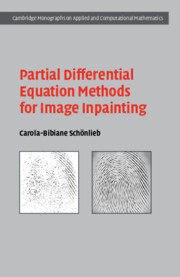Book contents
- Frontmatter
- Dedication
- Contents
- Preface
- 1 Introduction
- 2 Overview of Mathematical Inpainting Methods
- 3 The Principle of Good Continuation
- 4 Second-Order Diffusion Equations for Inpainting
- 5 Higher-Order PDE Inpainting
- 6 Transport Inpainting
- 7 The Mumford-Shah Image Model for Inpainting
- 8 Inpainting Mechanisms of Transport and Diffusion
- 9 Applications
- Appendix A Exercises
- Appendix B Mathematical Preliminaries
- Appendix C MATLAB Implementation
- Appendix D Image Credits
- Glossaries
- References
- Index
5 - Higher-Order PDE Inpainting
Published online by Cambridge University Press: 05 November 2015
- Frontmatter
- Dedication
- Contents
- Preface
- 1 Introduction
- 2 Overview of Mathematical Inpainting Methods
- 3 The Principle of Good Continuation
- 4 Second-Order Diffusion Equations for Inpainting
- 5 Higher-Order PDE Inpainting
- 6 Transport Inpainting
- 7 The Mumford-Shah Image Model for Inpainting
- 8 Inpainting Mechanisms of Transport and Diffusion
- 9 Applications
- Appendix A Exercises
- Appendix B Mathematical Preliminaries
- Appendix C MATLAB Implementation
- Appendix D Image Credits
- Glossaries
- References
- Index
Summary
The scope of this chapter is the presentation of inpainting methods which use fourth-order (and higher!) partial differential equations (PDEs) to fill in missing image contents in gaps in the image domain. In the following section, we first motivate the use of higher-order flows for image inpainting.
Second- Versus Higher-Order Approaches
In this section we want to emphasise the difference between second-order diffusions as discussed in Chapter 4 and higher-order – in particular, fourth-order – diffusions in inpainting. As we have seen already, second-order inpainting methods (in which the order of the method is determined by the derivatives of highest order in the PDE), such as total variation (TV) inpainting, have drawbacks when it comes to the connection of edges over large distances and the smooth propagation of level lines into the damaged domain – qualities that we agreed an image interpolator which follows the good continuation principle from Chapter 3 should have. The disability, in general, of second-order methods to connect structures across the inpainting domain was demonstrated for harmonic inpainting in Figure 4.1 and for TV inpainting in Figure 4.8. An example of the lack of smoothness of interpolated level lines is given in Figure 4.7 for TV inpainting. In the case of TV inpainting, this behaviour of the interpolator is explained using the co-area formula, Theorem 4.3.6. To remind ourselves, TV inpainting seeks an interpolator whose level lines have minimal length, thus connecting level lines from the boundary of the inpainting domain via the shortest distance (linear interpolation). In [MM98, Mas98 and Mas02], Masnou and Morel propose an extension of the length penalisation in TV inpainting by an additional curvature term that should be small for interpolating level lines.
- Type
- Chapter
- Information
- Partial Differential Equation Methods for Image Inpainting , pp. 63 - 136Publisher: Cambridge University PressPrint publication year: 2015

